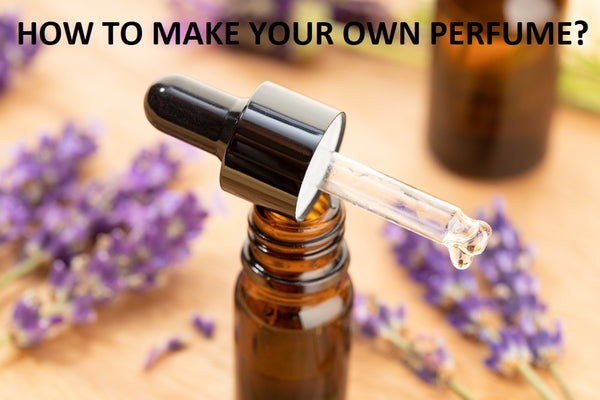How to make your own perfume at home, is it possible? The Saltworks Company
How to make perfume yourself?
We think of the famous films "Perfume" or "Jasminum" showing the complexity of the process of creating unique compositions. Making a perfume at home, however, does not have to mean going to the crime, as in the case of the main character of "Perfume". Combining essential oils can be fun, which often develops into a real passion for home cosmetics. here are the simple instructions on how to make a perfume yourself and composing unique compositions should look like.
What do you need to make your own perfume?
Homemade perfumes can come in various forms: liquid in a bottle of an atomizer or cream. Depending on which one you choose, when starting to compose your own perfume, it is worth having at home:
various essential oils imparting a fragrance to the composition;
alcohol in the form of an alcohol base for perfumes that can be ordered online or spirit (ethanol). It can also be ordinary vodka, which should then be carefully dosed due to its intense smell;
distilled water to dilute the composition;
a fragrance fixative like jojoba oil or glycerin to keep the perfume on your skin longer;
a coffee filter that allows the perfume to overflow after the process of combining essential oils and obtaining a completely pure composition;
beeswax for cream perfumes;
perfume storage containers. The best spray bottles are made of thick, dark glass.
All ingredients of this type can now be ordered online, on websites offering cosmetic intermediates, as well as in herbal or health food stores.
Properties of various forms of own perfume
Perfumes based on oil or beeswax are much more durable than those made with alcohol. They should be rubbed into the skin in places where blood is pulsating and it is warmer, i.e. on the wrists, neck, neck, cleavage, the place between the breasts and under them, as well as in the bends of the elbows and knees.
However, if we plan to create a perfume that we want to gently spray, alcohol will be required to compose it, which is mixed in a proportion of 80% to 20% with distilled water. However, it is worth knowing that due to its rapid airing, perfume with alcohol will be a little less durable.
Selection of essential oils for your own perfumes
The most important ingredients for creating a natural perfume are, of course, the essential oils. Perfume oils are highly condensed fragrances that need to be diluted. In undiluted form, they can irritate the skin, but if you use an appropriate ingredient to dilute them, their smell will gain durability.
The most commonly used essential oils in DIY perfumes include:
- lavender,
- from sweet orange,
- sandalwood,
- patchouli
- from lemongrass,
- from bergamot,
- cardamom,
- jasmine.
What should the fragrance pyramid of your own perfume look like?
As in the case of perfumes from global companies, DIY perfumes should be composed in accordance with the principles of the fragrance pyramid. All fragrances are divided into three notes:
- the scent note of the head (top, also called high), which we feel immediately after applying the perfume to the skin, but which also evaporates the fastest. Most often it uses floral and fruit aromas, e.g. bergamot, jasmine, lavender, lemon, neroli, lime, orchid, rose or oranges;
- middle note (heart) - longer lasting, being the core of the whole fragrance, often herbal or spicy, such as mint, chamomile, geranium, lemongrass, rosewood, nutmeg, pelargonium, ylang-ylang, neroli or marjoram;
- base note (base note) - characterized by the greatest durability and intensity.
Often these are fragrances such as oils obtained from cedar or sandalwood, rose, jasmine, vanilla, moss, patchouli and cinnamon.
Individual fragrance notes will blend smoothly with each other thanks to the use of the so-called connecting notes such as vanilla and lavender. We can also choose to use other, original substances, such as sea salt, which evokes the scent of the ocean, black pepper for spicy spice, camphor or vetiver.
Before we decide to create our own perfumes, it is worth knowing which fragrance groups each essential oil belongs to:
earthy smells - e.g. patchouli and vetiver,
floral scents - like geraniums, jasmine, neroli, rose, violet, ylang-ylang,
fruit fragrances - bergamot, lemon, grapefruit, lime, mandarin,Bitter orange, lemongrass,
herbal fragrances - e.g. basil, artemisia, lavender, mint, rosemary, sage,
sea scents - sea salt,
spicy aromas - like cinnamon, black pepper, nutmeg, clove, ginger, juniper, cardamom, coriander,
woody fragrances - cedar, cypress, sandalwood or pine.
How should you compose your own perfume?
The sequence of actions when composing your own perfume in the form of a cream is as follows:
Dissolving in a little pot
spray beeswax (preferably in a water bath) and add jojoba oil to it.
Pour the mixture into a closed container and cool the wax so that it does not weigh after adding essential oils. It is necessary at this stage to carefully observe the wax, which hardens very quickly.
Add essential oils to the wax in the following order:
the base notes first, the most enduring,
middle notes,
high notes, opening.
We mix everything and wait for the mass to solidify, which can be used at any time when we feel the need.
Another way, quite laborious and long-lasting, but completely natural, is to create your own perfume from the petals of your favorite flowers, such as lilies, lilies of the valley, lilacs, jasmine or roses. For this purpose, odorless fat (e.g. lard, beef tallow or coconut oil) is melted in a pot and poured into a flat vessel, creating a layer of several millimeters. After it solidifies, cut the fat layer with a knife, thanks to which the scent of flowers will penetrate deeper into it. Put a thin layer of flowers on the fat and set aside in a dark and cool place. After the flowers are withered, throw them away and replace them with fresh ones, at least four times, resulting in a fragrant pomade, which you scrape into a closed container.
The actions for creating alcohol-based perfumes will look slightly different. In this case, first add a fixative to the glass bottle: jojoba oil, sweet nut or almond oil. We combine it with essential oils, in the same order as in the case of cream perfumes (base notes - middle notes - high notes) and optionally top the whole composition with connecting notes. Finally, refill the container with alcohol and shake it for a few minutes. After mixing, the container should be stored in a dark, dry place for 18 hours to 6 weeks. If the smell turns out to be too intense, you can dilute it with a little distilled or spring water and shake the container thoroughly again. Finally, we have to pour the perfume into the atomizer through the coffee filter, which will allow you to get rid of any undesirable particles formed in the process of combining individual fragrance ingredients.
What do you need to know before making perfume?
The skillful combination of fragrance chords is a real art. It is not without reason that the world-famous perfume makers (the so-called noses) are admired so much. However, blending fragrances yourself can be great fun if you remember a few simple rules for creating successful compositions:
achieving a chypre aroma is possible after combining citrus and woody notes;
floral fragrances should be combined with other essential oils of the same category or fruit essences;
spicy, intense compositions can be achieved by combining wood fragrances with essences such as coriander, clove or nutmeg;
herbal fragrances give interesting compositions with citrus (lemon) or wood notes (e.g. vetiver);
spicy notes should be combined with resins or woody notes, creating deep, balsamic compositions;
Resin chords, in turn, give interesting effects combined with notes of wood, spice or citrus.
Why is it worth making a perfume yourself?
Playing with the composition of perfumes is certainly a good choice for individualists who are not satisfied with the commonly used fragrances that are perceived by many people. It allows you to spend time combining essential oils and experimenting with your favorite aromas in an interesting way. Let's also not forget that the ready-made compositions will be devoid of synthetic ingredients that may sensitize some people and they are certainly cheaper and often more durable perfumes than those found on the shelves in drugstores.


